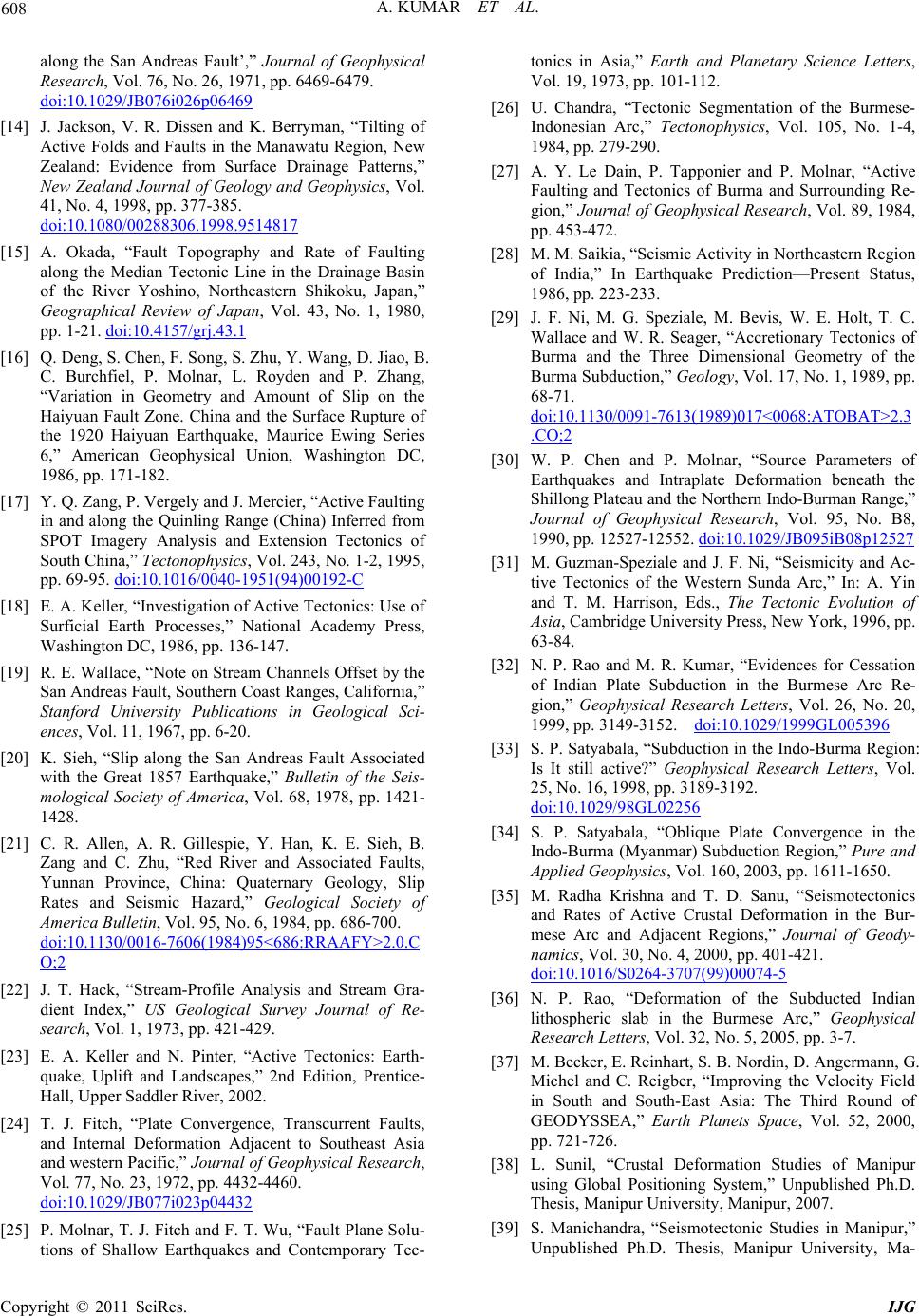
608 A. KUMAR ET AL.
along the San Andreas Fault’,” Journal of Geophysical
Research, Vol. 76, No. 26, 1971, pp. 6469-6479.
doi:10.1029/JB076i026p06469
[14] J. Jackson, V. R. Dissen and K. Berryman, “Tilting of
Active Folds and Faults in the Manawatu Region, New
Zealand: Evidence from Surface Drainage Patterns,”
New Zealand Journal of Geology and Geophysics, Vol.
41, No. 4, 1998, pp. 377-385.
doi:10.1080/00288306.1998.9514817
[15] A. Okada, “Fault Topography and Rate of Faulting
along the Median Tectonic Line in the Drainage Basin
of the River Yoshino, Northeastern Shikoku, Japan,”
Geographical Review of Japan, Vol. 43, No. 1, 1980,
pp. 1-21. doi:10.4157/grj.43.1
[16] Q. Deng, S. Chen, F. Song, S. Zhu, Y. Wang, D. Jiao, B.
C. Burchfiel, P. Molnar, L. Royden and P. Zhang,
“Variation in Geometry and Amount of Slip on the
Haiyuan Fault Zone. China and the Surface Rupture of
the 1920 Haiyuan Earthquake, Maurice Ewing Series
6,” American Geophysical Union, Washington DC,
1986, pp. 171-182.
[17] Y. Q. Zang, P. Vergely and J. Mercier, “Active Faulting
in and along the Quinling Range (China) Inferred from
SPOT Imagery Analysis and Extension Tectonics of
South China,” Tectonophysics, Vol. 243, No. 1-2, 1995,
pp. 69-95. doi:10.1016/0040-1951(94)00192-C
[18] E. A. Keller, “Investigation of Active Tectonics: Use of
Surficial Earth Processes,” National Academy Press,
Washington DC, 1986, pp. 136-147.
[19] R. E. Wallace, “Note on Stream Channels Offset by the
San Andreas Fault, Southern Coast Ranges, California,”
Stanford University Publications in Geological Sci-
ences, Vol. 11, 1967, pp. 6-20.
[20] K. Sieh, “Slip along the San Andreas Fault Associated
with the Great 1857 Earthquake,” Bulletin of the Seis-
mological Society of America, Vol. 68, 1978, pp. 1421-
1428.
[21] C. R. Allen, A. R. Gillespie, Y. Han, K. E. Sieh, B.
Zang and C. Zhu, “Red River and Associated Faults,
Yunnan Province, China: Quaternary Geology, Slip
Rates and Seismic Hazard,” Geological Society of
America Bulletin , Vol. 95, No. 6, 1984, pp. 686-700.
doi:10.1130/0016-7606(1984)95<686:RRAAFY>2.0.C
O;2
[22] J. T. Hack, “Stream-Profile Analysis and Stream Gra-
dient Index,” US Geological Survey Journal of Re-
search, Vol. 1, 1973, pp. 421-429.
[23] E. A. Keller and N. Pinter, “Active Tectonics: Earth-
quake, Uplift and Landscapes,” 2nd Edition, Prentice-
Hall, Upper Saddler River, 2002.
[24] T. J. Fitch, “Plate Convergence, Transcurrent Faults,
and Internal Deformation Adjacent to Southeast Asia
and western Pacific,” Journal of Geophysical Research,
Vol. 77, No. 23, 1972, pp. 4432-4460.
doi:10.1029/JB077i023p04432
[25] P. Molnar, T. J. Fitch and F. T. Wu, “Fault Plane Solu-
tions of Shallow Earthquakes and Contemporary Tec-
tonics in Asia,” Earth and Planetary Science Letters,
Vol. 19, 1973, pp. 101-112.
[26] U. Chandra, “Tectonic Segmentation of the Burmese-
Indonesian Arc,” Tectonophysics, Vol. 105, No. 1-4,
1984, pp. 279-290.
[27] A. Y. Le Dain, P. Tapponier and P. Molnar, “Active
Faulting and Tectonics of Burma and Surrounding Re-
gion,” Journal of Geophysical Research, Vol. 89, 1984,
pp. 453-472.
[28] M. M. Saikia, “Seismic Activity in Northeastern Region
of India,” In Earthquake Prediction—Present Status,
1986, pp. 223-233.
[29] J. F. Ni, M. G. Speziale, M. Bevis, W. E. Holt, T. C.
Wallace and W. R. Seager, “Accretionary Tectonics of
Burma and the Three Dimensional Geometry of the
Burma Subduction,” Geology, Vol. 17, No. 1, 1989, pp.
68-71.
doi:10.1130/0091-7613(1989)017<0068:ATOBAT>2.3
.CO;2
[30] W. P. Chen and P. Molnar, “Source Parameters of
Earthquakes and Intraplate Deformation beneath the
Shillong Plateau and the Northern Indo-Burman Range,”
Journal of Geophysical Research, Vol. 95, No. B8,
1990, pp. 12527-12552. doi:10.1029/JB095iB08p12527
[31] M. Guzman-Speziale and J. F. Ni, “Seismicity and Ac-
tive Tectonics of the Western Sunda Arc,” In: A. Yin
and T. M. Harrison, Eds., The Tectonic Evolution of
Asia, Cambridge University Press, New York, 1996, pp.
63-84.
[32] N. P. Rao and M. R. Kumar, “Evidences for Cessation
of Indian Plate Subduction in the Burmese Arc Re-
gion,” Geophysical Research Letters, Vol. 26, No. 20,
1999, pp. 3149-3152. doi:10.1029/1999GL005396
[33] S. P. Satyabala, “Subduction in the Indo-Burma Region:
Is It still active?” Geophysical Research Letters, Vol.
25, No. 16, 1998, pp. 3189-3192.
doi:10.1029/98GL02256
[34] S. P. Satyabala, “Oblique Plate Convergence in the
Indo-Burma (Myanmar) Subduction Region,” Pure and
Applied Geophysics, Vol. 160, 2003, pp. 1611-1650.
[35] M. Radha Krishna and T. D. Sanu, “Seismotectonics
and Rates of Active Crustal Deformation in the Bur-
mese Arc and Adjacent Regions,” Journal of Geody-
namics, Vol. 30, No. 4, 2000, pp. 401-421.
doi:10.1016/S0264-3707(99)00074-5
[36] N. P. Rao, “Deformation of the Subducted Indian
lithospheric slab in the Burmese Arc,” Geophysical
Research Letters, Vol. 32, No. 5, 2005, pp. 3-7.
[37] M. Becker, E. Reinhart, S. B. Nordin, D. Angermann, G.
Michel and C. Reigber, “Improving the Velocity Field
in South and South-East Asia: The Third Round of
GEODYSSEA,” Earth Planets Space, Vol. 52, 2000,
pp. 721-726.
[38] L. Sunil, “Crustal Deformation Studies of Manipur
using Global Positioning System,” Unpublished Ph.D.
Thesis, Manipur University, Manipur, 2007.
[39] S. Manichandra, “Seismotectonic Studies in Manipur,”
Unpublished Ph.D. Thesis, Manipur University, Ma-
C
opyright © 2011 SciRes. IJG